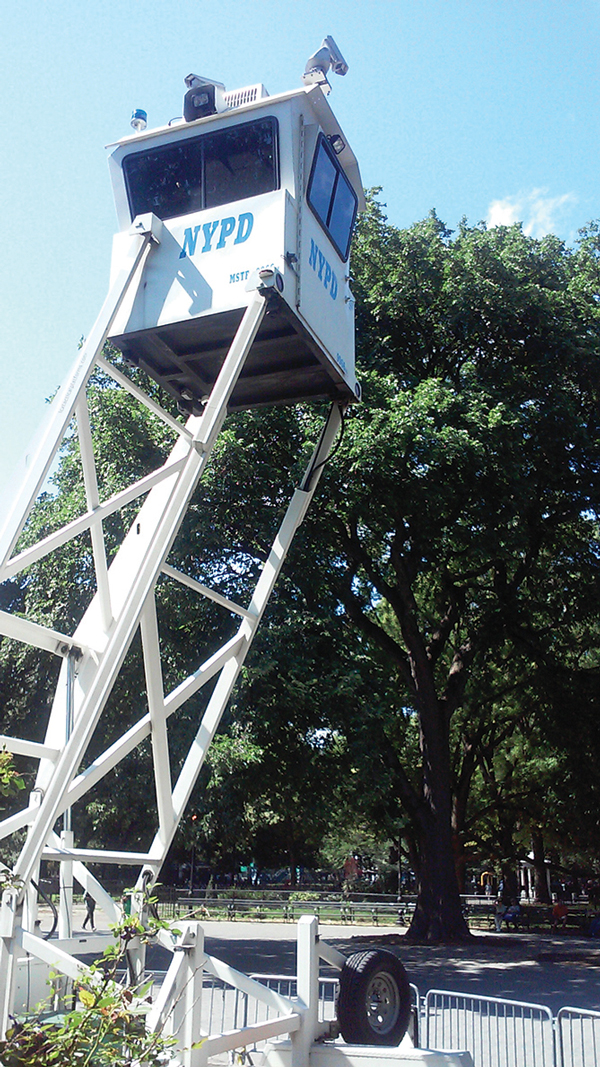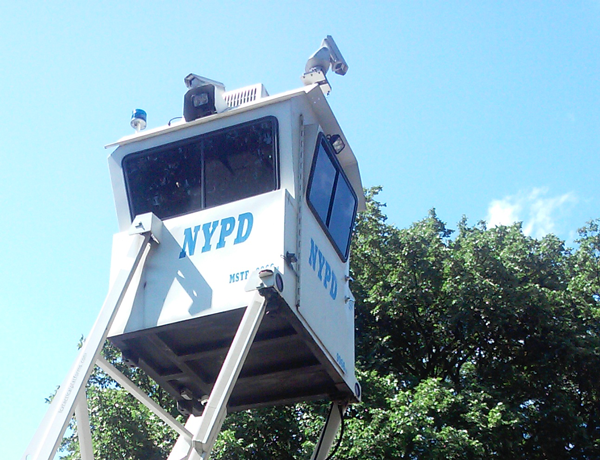
BY YANNIC RACK | The East Village went back to business as usual this Tues., July 28, as police removed a mobile surveillance tower from Tompkins Square Park that had angered local residents for a week.
The “Orwellian” structure, as some described it, was erected in the middle of the park — near the former band shell site — on July 21, and was mostly seen as an unnecessary nuisance — if not worse.
“It’s like the gestapo. It’s absurd,” said Helen Stratford, sitting nearby on a bench last Friday.
Stratford, who usually plays her accordion beneath the Hare Krishna Tree there, thought the tower had been put up to scare off the homeless who regularly populate the park.
“It’s trying to get rid of the disparaging element,” she said. “You’d have homeless people here, but they were never a menace.”
“I think it’s twisted,” agreed Dorothy Wilson, who lives a block and a half away from the park.
“This park is a walk in the park compared to how it was in the early Eighties,” she said. “You just didn’t come here. It was dangerous.
“This is paradise,” she added, looking around at the dog walkers and loungers enjoying the sunny weather.
The new security presence — a SkyWatch tower that records video in a 360-degree radius and is usually dispatched to high-crime neighborhoods — came hot on the heels of recent visits to the park by both Mayor Bill de Blasio and Police Commissioner Bill Bratton.
Last week, many parkgoers were all but certain that both the appearences by the top officials and the erection of the tower were a result of a July 10 article in the New York Post, detailing the park’s “homeless problem.”
Under the headline “Going to the park? Don’t trip on a bum,” the tabloid depicted Tompkins Square as a “homeless shelter” teeming with “vagrants.”
A subsequent editorial in the New York Observer went further and called for concrete action to rid the park of homeless people.
“Allowing homeless people to take over even a corner of the park invites more problems,” it read. “For decades, Tompkins Square Park was a dangerous haven for every imaginable crime, to the point where it was known as ‘Needle Park.’ Those days are hurtling back to us with alarming speed.”
But not everybody agreed with that assessment.
Curtis Brown, who owns a restaurant on E. Fourth St., was passing through the park with his son Wally on Friday when they stopped to take a photo of the tower.
Looking down onto the park’s main square from 20 feet above, the structure seemed out of place, like an awkward visitor. Right next to it, two female police officers were eating lunch in their idling patrol car.
“It’s actually a little scary, it’s ridiculous,” Brown said, adding that the tower didn’t make him feel safer at all.
“We’ve been gentrified. In the old days, that was romantic,” remarked David, a retired doorman, gesturing at the few people left sleeping on the grass.
This past Friday the park was almost empty of a certain group of its “regulars,” who can usually be seen sleeping on benches and on the lawns throughout the park.
A few were passed out among the chess tables at the park’s southwest corner, but “Crusty Row”, named for the traveling crust punks that frequent it, was almost completely empty.
“Tompkins Square Park is closed every night by N.Y.P.D., who also patrol the area during off hours,” a Parks Department spokesperson said in a statement last week. “In addition, N.Y.C. Parks works closely with the Department of Homeless Services to engage chronically homeless individuals and offer them services and support.
“Sleeping during the day in a park is legal — just as sunning oneself on a beach or lying down on a picnic blanket is — and homelessness is not a crime, it is a symptom of larger inequality issues that this administration is addressing every day, at all levels,” the Parks spokesperson’s statement continued.
“D.H.S. outreach teams work every day to engage individuals who appear to be living in public spaces and offer them shelter and appropriate services. The city’s street homeless operation has expanded significantly under Mayor de Blasio.”
Although the Police Department did not respond to a request for comment, and it is still unclear what eventually brought the tower down, by last week some residents had started taking matters into their own hands.
Penny Rand, who has lived in the East Village since 1968, started a petition last Wednesday to remove the tower. Six days later, it had gathered more than 600 signatures.
“There is a certain feeling in the neighborhood that this is complete overkill,” Rand said last Friday, sitting on a bench in the park’s dog run.
“They have undercover police in the park, they have patrol cars in the park,” she said. “They could up patrols, nobody would object to that.
“I just don’t like it. I feel watched. People say if you’re not doing anything wrong, it shouldn’t bother you. But I’m sorry, we don’t live in the Soviet Union, that’s long gone.”
This Tuesday, Rand said she was glad the tower had been removed but that she had sent the petition to the mayor anyway.
The cops’ eye in the sky also attracted opposition from local children, who sang Tom Petty’s “Won’t Back Down” in front of it as part of the Middle Collegiate Church’s “Just Arts” program.
“We’ve been coming here in the afternoons to rehearse, and we noticed it and talked about police presence,” said Reverend Jim Kast-Keat, who took the kids to the park last Friday. “So we were singing freedom songs in front of the police tower. It gives a beautiful irony.”
A dedicated Twitter account, NYPD Tweet Tower, was also set up anonymously last week and kept turning out a steady stream of jokes over the weekend.
“To whoever stole the tweet tower while Officer Tubbs and I were playing in the dog pool: Return it!” was the all-caps reaction tweeted out on Tuesday.
In the end, this confrontation between the police and East Village residents blew over almost as quickly as it started, especially considering the history of Tompkins Square Park, where a riot famously broke out in 1988 when police attempted to clear the park of homeless people.
A weekend-long “campout” starting Fri., Aug. 7, had been organized via Facebook to protest the tower and “celebrate the 27 years since the bloody NYPD riot that injured hundreds of innocent and unaware local citizens in our neighborhood.”
According to John Penley, one of the event’s organizers, during the day, the campout’s activities — including dancing to ’80s music from a boom box, art, free food and organizing — will be centered around the park’s “Hippie Hill.” At night, after the curfew, they will move to the E. Seventh St. sidewalk outside the park. The campout also coincides with this year’s anniversary concerts commemorating the 1988 riots.
Paul DeRienzo, another one of the event’s organizers, on Tuesday assured that the campout, which around 200 people have signed up for so far, would take place despite the tower’s removal.
“Although the N.Y.P.D. ‘sniper tower’ has been removed,” an update on the Facebook page read, “the odious anti-homeless-person atmosphere drummed up by the NY Post continues to heap derision and disrespect on homeless people. These people, these citizens and human beings…are just trying to make a life.”
The Facebook page statement also referred to the real estate interests that many say are corrupting the neighborhood — and which some allege also drove the police to bring in the tower in the first place. Jared Kushner, the Observer’s publisher, coincidentally owns extensive real estate in the East Village, they note.
DeRienzo said that many residents saw the tower as a personal insult, and that he would leave it up to everyone whether they would still attend the campout out of principle.
“It was always really about the homeless,” he said. “I don’t think anybody really knows why they put that tower up there, but if that tower was meant to unify the neighborhood to do something about the homeless, then they did that. If it was there to intimidate and scare us away into not being political and not organizing for our rights, then it was a disaster. We’ll definitely still be there.”


















